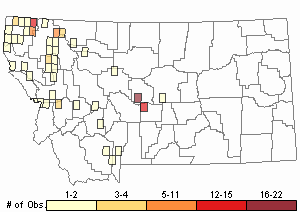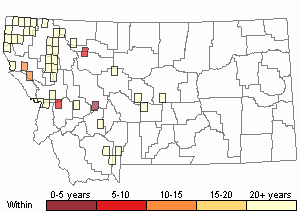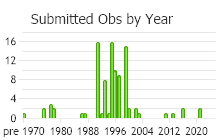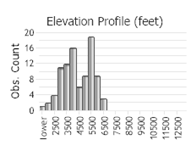View in other NatureServe Network Field Guides
NatureServe
Montana
Utah
Wyoming
Idaho
Wisconsin
British Columbia
South Carolina
Yukon
California
New York
Splendid Stairstep Moss - Hylocomium splendens
Other Names:
Mountain Fern Moss
General Description
Plants: Pleurocarpous (Vitt 1988), growing in open mats, green or green with yellow tones, sometimes brown proximally (Lawton 1971). Stems sometimes reaching 20 cm (FNA 2014), typically red, the base essentially lying flat, arching or becoming upright above (Lawton 1971), sympodial (FNA 2014), with the new annual growth developing from about the middle of the former year’s stem (Lawton 1971), “forming an ascending series of flat, frondose tiers”; fronds mostly 20-50 mm in width (in smaller arctic-alpine plants, as little as 8 mm); paraphyllia numerous, several cells wide at the base, their branches 1 or 2 cells in width (FNA 2014).
Stem Leaves: Somewhat loosely arranged, pressed to the stem, pointing in various directions (FNA 2014), 2-3 mm in length (Crum and Anderson et al. 1981), weakly pleated, egg-shaped, occasionally somewhat rectangular, long-acuminate, the acumen occasionally very wavy transversely (FNA 2014), bent and twisted (Crum and Anderson et al. 1981), the base not extending down the stem; leaf edges below finely saw-toothed to smooth, distally saw-toothed or finely so; costa double, short, sometimes reaching mid-leaf (FNA 2014).
Branch Leaves: Primary branch leaves spreading to 45 degrees, 0.8-2 mm in length, 0.3-0.9 mm in width, cupped, egg-shaped to widest about mid-leaf, with a dully-acute to more widely-angled acumen; leaf edges widely curved inward distally, suddenly curved or bent down and inward below. Leaves of secondary branches smaller and a little narrower, egg-shaped to somewhat lance-shaped, sometimes widest about mid-leaf (FNA 2014).
Leaf Cells: Upper laminal cells occasionally papillose from cell ends overlapping in spots (Crum and Anderson et al. 1981); median laminal cells longer and more slender than the basal cells; basal cells porose, thick, frequently yellow (Lawton 1971); alar cells not distinct from adjacent cells (FNA 2014).
Diagnostic Characteristics
Plants exhibit a continuum of forms from the smaller tundra plants that are 1- to 2-times pinnate and typically without the ascending innovations, to the larger, 3-pinnate plants of the Pacific Northwest rainforests with their abundant stair-step innovations (FNA 2014).
Range Comments
North American Range
Canada: Found in all provinces and territories; USA: AK, WA to CA, ID, MT to CO, SD, IA, MN to NY and states e and ne to ME, PA to TN and states east, also GA (FNA 2014). Known in Montana from Carbon, Cascade, Fergus, Flathead, Gallatin, Glacier, Granite, Lake, Lincoln, Madison, Meagher, Missoula, Park, Powell, and Sanders Counties (Elliott and Pipp 2016).
Observations in Montana Natural Heritage Program Database
Number of Observations: 129
(Click on the following maps and charts to see full sized version)
Map Help and Descriptions
Relative Density

Recency



 (Observations spanning multiple months or years are excluded from time charts)
(Observations spanning multiple months or years are excluded from time charts)
Habitat
Soil, decayed organic matter, including wood, also stone (FNA 2014), on the sides of steep, well-shaded gorges, swampy woods (Crum and Anderson et al. 1981); in northern evergreen forests and tundra; ranging from lowlands to 12,140 feet (FNA 2014).
Reproductive Characteristics
Dioicous. Perigonia developing on stems or main branches. Perichaetia occurring on the stems, the leaves to 5 mm and typically at a 90-degree angle to the stem (Lawton 1971). Seta brownish to somewhat red, a little bent or twisted (Crum and Anderson et al. 1981), 5-25 mm tall (FNA 2014), smooth. Capsule level (Lawton 1971), 1.7-2.8 mm in length, with an evident neck; exostome with a fine network of lines below; endostome with wide openings (the openings sometimes joined into one) (FNA 2014).
Stewardship Responsibility
References
- Literature Cited AboveLegend:
 View Online Publication
View Online Publication Crum, H.A. and L.E. Anderson. 1981. Mosses of Eastern North America. 2 volumes. Columbia University Press, New York. 1328 pp.
Crum, H.A. and L.E. Anderson. 1981. Mosses of Eastern North America. 2 volumes. Columbia University Press, New York. 1328 pp. Elliott, J.C. and A.K. Pipp. 2018. A Checklist of Montana Mosses (1880-2018). Updated 3 January, 2020. Montana Natural Heritage Program, Helena, Montana. 73 pp.
Elliott, J.C. and A.K. Pipp. 2018. A Checklist of Montana Mosses (1880-2018). Updated 3 January, 2020. Montana Natural Heritage Program, Helena, Montana. 73 pp. Flora of North America Editorial Committee, eds. 2014. Flora of North America North of Mexico. Volume 28. Bryophytes: Mosses, Part 2. Oxford University Press, Inc., NY. xxi + 702 pp.
Flora of North America Editorial Committee, eds. 2014. Flora of North America North of Mexico. Volume 28. Bryophytes: Mosses, Part 2. Oxford University Press, Inc., NY. xxi + 702 pp. Lawton, E. 1971. Moss Flora of the Pacific Northwest. Hattori Botanical Laboratory. Japan: Yamabuki-cho, Shinjuku-ku, Tokyo. 362 pages plus appendices.
Lawton, E. 1971. Moss Flora of the Pacific Northwest. Hattori Botanical Laboratory. Japan: Yamabuki-cho, Shinjuku-ku, Tokyo. 362 pages plus appendices. Vitt, D. J. Marsh, and R. Bovey. 1988. Mosses, Lichens & Ferns of Northwest North America. Seattle, WA: University of Washington Press. 296 p.
Vitt, D. J. Marsh, and R. Bovey. 1988. Mosses, Lichens & Ferns of Northwest North America. Seattle, WA: University of Washington Press. 296 p.
- Additional ReferencesLegend:
 View Online Publication
View Online Publication
Do you know of a citation we're missing? Elliot, J. C. 1993. Second checklist of Montana mosses. Unpublished report. U.S. Forest Service, Region 1. Missoula, MT. 45 pp.
Elliot, J. C. 1993. Second checklist of Montana mosses. Unpublished report. U.S. Forest Service, Region 1. Missoula, MT. 45 pp. Lawton, E. 1971. Keys for the Identification of the Mosses on the Pacific Northwest. Reprinted from 'Moss Flora of the Pacific Northwest'. Published as Supplement No. 2 of the Journal of the Hattori Botanical Laboratory. Nichinan, Miyazaki, Japan. 66 pp.
Lawton, E. 1971. Keys for the Identification of the Mosses on the Pacific Northwest. Reprinted from 'Moss Flora of the Pacific Northwest'. Published as Supplement No. 2 of the Journal of the Hattori Botanical Laboratory. Nichinan, Miyazaki, Japan. 66 pp. Malcolm, B., N. Malcolm, J. Shevock, and D. Norris. 2009. California Mosses. Nelson, New Zealand: Micro-Optics Press. 430 pp.
Malcolm, B., N. Malcolm, J. Shevock, and D. Norris. 2009. California Mosses. Nelson, New Zealand: Micro-Optics Press. 430 pp. Smith, A.J.E. 1980. The Moss Flora of Britain and Ireland. Cambridge University Press, Cambridge. 705 pp.
Smith, A.J.E. 1980. The Moss Flora of Britain and Ireland. Cambridge University Press, Cambridge. 705 pp.
- Web Search Engines for Articles on "Splendid Stairstep Moss"





